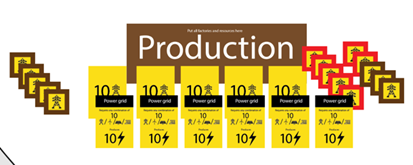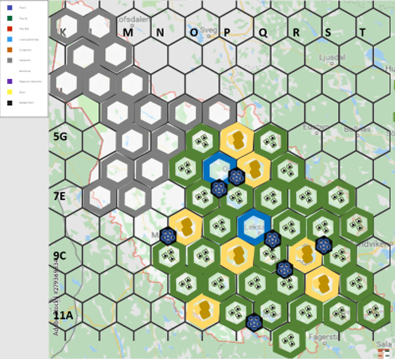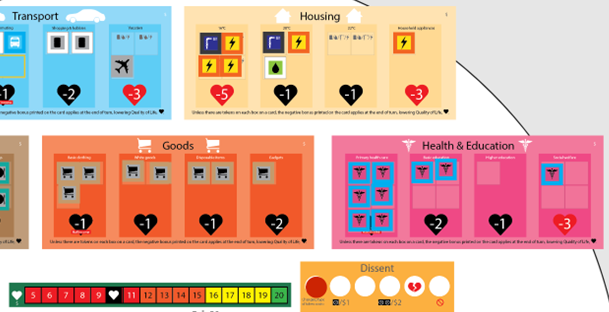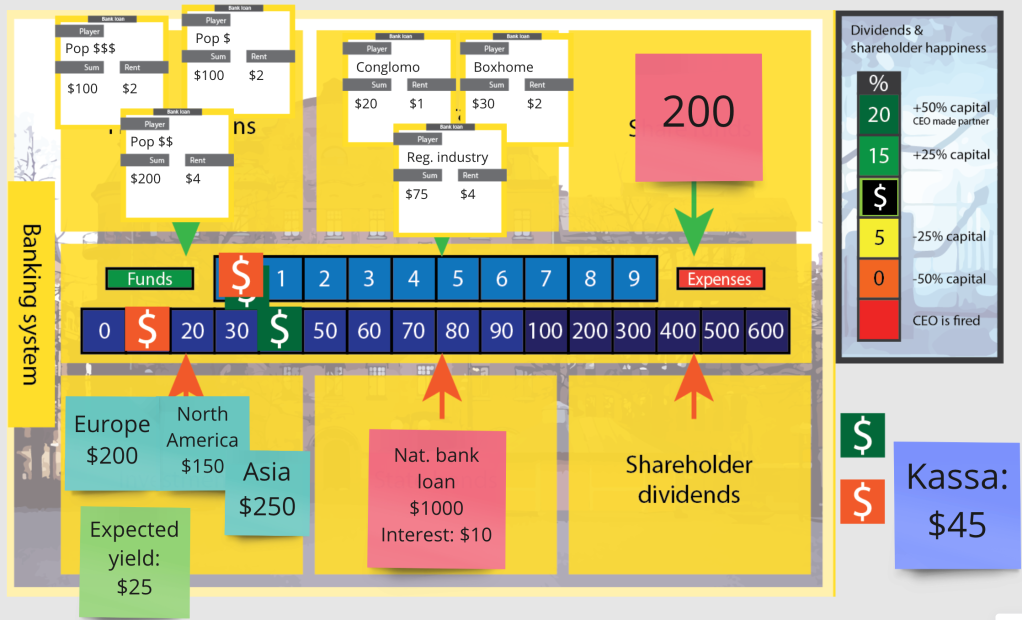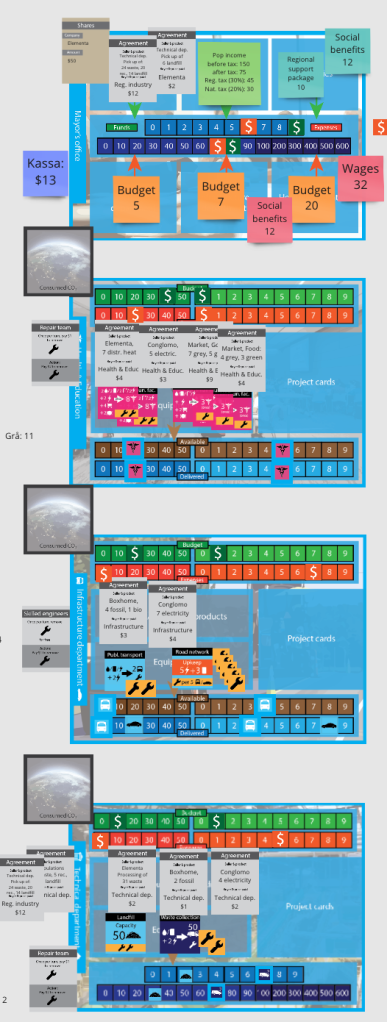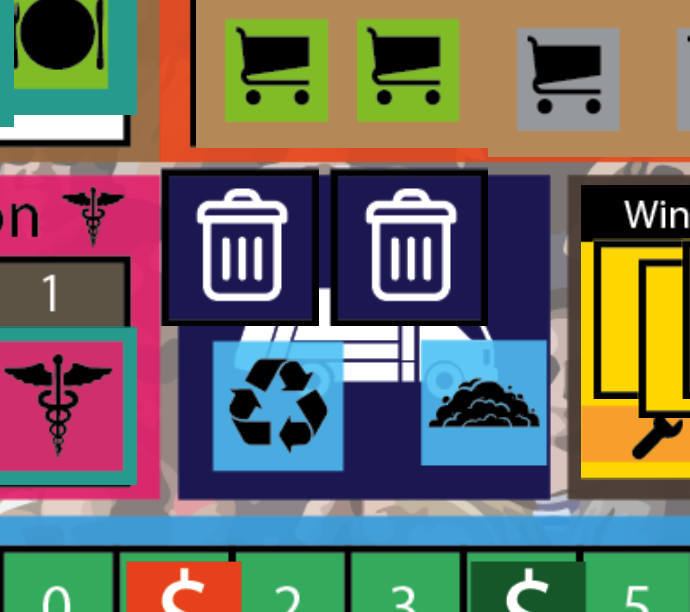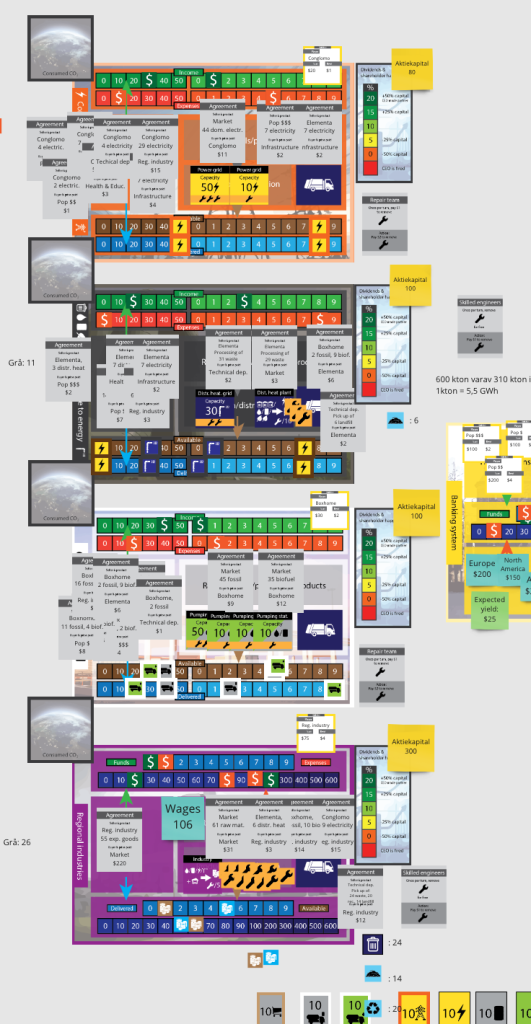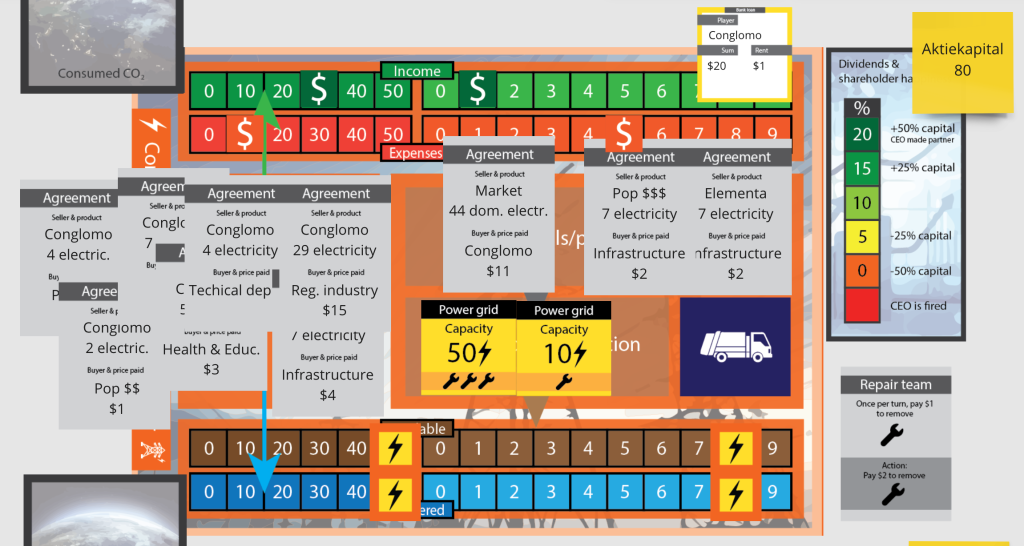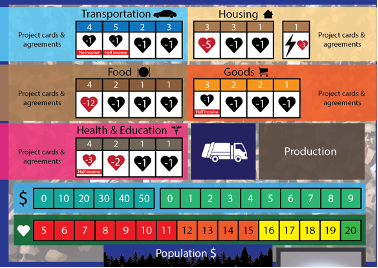Don’t all players need to have a positive experience during the game for them to learn anything? This question was brought to light by the fate of the low-income population players during the Borlänge playtest (see previous blog post). The players on that team had expected to play a game about ‘the energy system’, and were unprepared for the task of handling the transition to sustainable energy consumption of an entire section of the population while dealing with severe shortages in e.g. healthcare and education and energy for heating their houses to a comfortable 22°C. They worked together with the Director of Healthcare & Education to get new hospitals and had very promising plans for lifestyle changes and decentralised living when disaster struck in the form of a wave of unrest and then the rise of organised crime. In the end, they concluded that they were unable to do anything about the situation as they had insufficient funds (low income and high expenses), and that the game had left them with their hands tied.
The players were already looking pretty tired when they on Turn 4 had to handle a wave of vandalism and extorsion instigated by their own disgruntled citizens after 15 years of rising dissent due to what they interpreted as their community leaders’ (the players on the team) inability to improve their living conditions. The proverbial hair that broke the camel’s back came the following turn, when they after celebrating that they had managed to improve their Quality of Life to an acceptable level were given the news that 100,000 immigrant workers had joined their population – this required them to obtain even more resources in order not to cause a new wave of dissent and further aggravate the situation with the crime wave. All the players at the table left the game shortly after this – not owing to being frustrated, but to previous engagements – and so was unable to attend the debriefing session. I spoke to them just before they left and they said they ‘hadn’t done anything even remotely related to the energy system all day long’.
A very natural reaction to this that something must be wrong with the game or the setup, as the experience of a player needs to be positive and empowering in order for learning to take place. In answer to this, I give you two reflections I’ve made during my time as a megagame designer (a few years, which is arguably a relatively short time):
The first is that it is my experience that people learn from experiences that affect them on an emotional level. In this case, the players were frustrated and so the game had affected them – the question is only what they would learn. Here, a game host needs to plan carefully in order to maximise chances that players learn something that will be beneficial to the intended learning outcomes, i.e. the reason we host the game and invite the players to participate in the first place. As the players had to leave early and so missed the debriefing session, our opportunity as game hosts of having them reflect on what the (frustrating) events of the game meant in terms of a sustainable energy system (where in my view they had gained very important insights into how the need for energy affected those who didn’t have the resources to obtain it) was lost, as was our opportunity to use their experiences and frustration to help the other players (some of which were very pleased with attaining their goals without too much trouble) reflect on their own success against the backdrop of the rather grim fate of the low-income population. In light of this, an assumption such as that for learning to take place all players should have the same ability to influence and, by extension, succeed in the game is only valid if one also assumes that all players either won’t process their experience or will only do so on their own, i.e. the kind of processing you would expect from people who have played a single-player computer game.
My second reflection is that megagames by nature are hierarchical, as often some teams give orders to others and some players lead their teams, and thus all players do not have equal influence on every part of the game. That said, all players should have the same amount of agency in the game: this means that all players should enjoy the same freedom to go outside the rules and invent methods of influencing the game via the role-playing part of the megagame handled by negotiating with members of the Control team (who will mostly give them a ‘yes, and…’ kind of answer and have them roll dice to determine the cost and level of success). As an example, take the group of players inventing a criminal empire on Turn 1 of the playtest of the Changing the Game of Consumption megagame (see this blog post): their creativity impacted the game quite a lot (they more or less bought the local politician on the last turn), and none of this came from their role descriptions or any rules relating to the table they played. In a megagame, we thus need to be clear about the difference between agency of the player (equal) and the influence of the player’s role (limited by/tied to their place in a hierarchy).
What these two reflections amount to in the case of the fate of the low-income population in the Borlänge playtest, I will present you with my reasoning as the member of the Control team reacting to what was happening in the game: I my view, the players started out trying to ‘win the game’ by playing by the rules as best they could (they were, as most of the people we play with, first-time players), which enabled the inequality inherent in their roles to gain full momentum, pushing them very quickly down a slippery slope which was present in the game setup. As in real life, however, at the bottom of that slope wasn’t the end of the game but new options – at the cost of the players accepting a change to the way they played game, in this case the players being given means to incentivise other players to share resources that they hadn’t offered freely earlier in the game and/or incentivise the players of the low-income population team to sacrifice their pride/abandon their unwillingness to ask for alms. This is my understanding of how agency works in megagames – when a player’s role hits a wall, the player is free to explore options not covered by the original mechanics of the role (which surprisingly often involves choices which are doubtful from a moral perspective), and as a member of the Control team I’m obliged (and free) to assist in players who are at a loss for what to do with options that I can see based on my understanding of the game.
As for the game and the hosting of game events, it’s my belief that achieving a positive learning outcome after playing the game is entirely dependent on the players reflecting on the game experience together in groups, sharing their experiences so as to form a whole that isn’t limited to an individual player’s experiences. This processing of what has happened in during the game can take the form of structured debriefing sessions or gathering over a pint at the pub afterwards – however it is done, it is crucial that players are made aware (before the game, and reminded afterwards) that whatever they experience during the game, it is of the utmost importance that they give themselves time to process the experience and make sense of it together with other players. Ultimately, what I want for participants in our games is to form as many mental links between the game experience and their aggregated life experience as they can. Otherwise, all we have is a game that is entirely unrelated to reality, and thus more or less useless in helping people who play them see the world in a new way.



